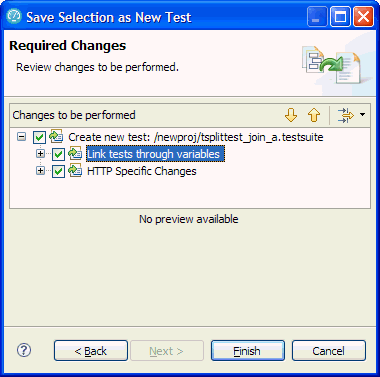Split a test
Overview
After recording a test, you can split it into smaller tests. By splitting a test, you can create modular building blocks of smaller tests and combine them to make bigger tests. The original test is unchanged.
With the test-splitting capability, you can record a relatively long scenario with many functional steps against an application and then, in the editor, dissect the test into many smaller test segments, which you can run in various orders in a schedule. The wizard determines which variables need to persist among the split tests and creates the linkage so that you do not have to write custom code.
Split a test
- In the Test Navigator, browse to the test and double-click it.
- Select one or more elements in the test for splitting into a new test.
Select contiguous elements. You can select elements, except for variable containers, that are immediate children of the root node of the test.
- Right-click the selected elements, and then select...
-
Save Selection As New Test
- Type a file name for the new test, and optionally provide a description or comment for the split test.
- To add the Description/comment field as a comment at the beginning of the split test, select...
-
Also use description text for comment at beginning of each test
- To mark the selection in the original test with marks of the form [N-> where N is a positive integer that corresponds to the number of saved selections, select...
-
Mark the selection in the editor
For example, the first time you save a selection as a new test, the selection in the original test is marked with this identifier:[1->. If you save three selections, the original test is marked with these identifiers:
-
[1->, [2->, and [3->
- Click Next.
Selecting Mark the selection in the editor makes it easier to split a test into multiple parts. The marks in the editor are removed when you close the test. You cannot save marked test elements. Right-click and select...
-
Clear Range
to remove the marks if to save the selected test elements again.
- To add the Description/comment field as a comment at the beginning of the split test, select...
- Optional: On the next page of the Save Selection as New Test wizard, examine the changes to be performed as a result of the split.
Typically, you leave Link tests through variables and HTTP Specific Changes selected; clearing these options might make a split test unusable or produce unpredictable results. However, you can clear specific Link tests through variables boxes if you do not want certain data to be correlated between the tests.

- Click Finish.
Results
The new test is created from the selected elements. The test variables that are created by splitting a test are listed in the Variables Created by Split Test container in the new test. For best results, open the Variables Created by Split Test container in the new test and make sure that the variables are created and assigned with values by a test executed before the newly split test.
The original test is marked if you select the Mark the selection in the editor option. To remove the marks, right-click the selected elements in the original test and select Clear Range. You are also prompted to delete the new test. Click Yes to delete the new test or No to preserve it.
Example
Be aware of the choices that you make when you split a test and rearrange the split tests in a schedule. Assume that the visitIBM recorded test contains the following actions:
- Logging on to a server.
- Create an entry on the server and removing the entry.
- Edit an entry, validating that the change occurred, and restoring the entry.
- Logging off of the server.
You want to split the test into four parts: Logon, Create, Edit, and Logoff. You need to split the test four times.
- Open visitIBM and select the logon actions. Name the new test Logon, which contains the Logon actions.
- Select the create actions. Name the new test Create.
- Select the edit actions. Name the new test Edit.
- Select the logoff actions. Name the new test Logoff.
You then create a schedule that runs virtual users selected from a datapool. Each virtual user runs the Logon test, performs various combinations of the Create and Edit tests, and finally runs the Logoff test.
Be aware, however, that when you split the tests, the Create test might have initialized variables that the Edit test uses. Therefore, if you reverse the order during the run (, run the Edit test before the Create test), make sure that the variables that the tests share are initialized and set correctly.
Related:
Redirection support for HTTP tests
HTTP test editor overview
Cut and paste in tests
Specify the number of allowable URL redirects during test runs
Define performance requirements in tests
Add an authentication folder
Verify expected behavior
Specify error-handling behavior
How loops affect the state of virtual users
Split a test page
Merge test pages
Disable and enable secondary HTTP requests
Reuse tests on different hosts: Server connection variables
Convert tests to use SSL connections
View a test in the Protocol Data view
Test Siebel applications
Split an HTTP test during recording
Error 404 - Not Found
The document you are looking for may have been removed or re-named. Please contact the web site owner for further assistance.